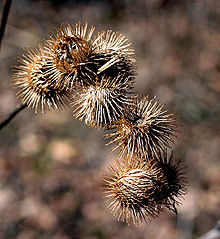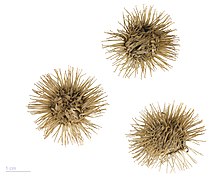Big burdock
| Big burdock | ||||||||||||
|---|---|---|---|---|---|---|---|---|---|---|---|---|

Great burdock ( Arctium lappa ) |
||||||||||||
| Systematics | ||||||||||||
|
||||||||||||
| Scientific name | ||||||||||||
| Arctium lappa | ||||||||||||
| L. |
The Burdock ( Arctium lappa ), also called Butzenklette is a plant from the genus of barnacles ( Arctium ) within the family of the daisy family (Asteraceae).
description
Vegetative characteristics
Like the other species in the genus, the greater burdock is a biennial herbaceous plant . It forms a woody taproot . The upright and 80 to 150 centimeter high shoot axes (stems) are angular and hairy like a cobweb.
The stems of the basal leaves are pithy. The simple leaf blades are heart-shaped-oval with a length of up to 50 centimeters. The underside of the leaf is hairy bald to slightly gray-tomentose.
Generative characteristics
Spherical flower heads with a diameter of 3 to 5 centimeters stand on inflorescence shafts up to 10 centimeters long . The almost bare bracts have a brownish-yellow tip that is hooked and curved and as long as or longer than the flowers. The flowers are red to purple in color and appear between July and September.
The achenes are 6 to 8 millimeters long. They are wider at the top than at the bottom and are indistinctly angular and bald. At the top, the achenes have a bristle ring made of tiny, pointed cardboard hairs , which can be dangerous for those who handle ripe burdock. The spread happens through epichory , in that the fruit clusters with the barbs get caught in the fur of animals and are thus spread.
Chromosome number
The number of chromosomes is 2n = 36.
Occurrence
The great burdock is common in Eurasia . The main distribution area is Europe without the Iberian Peninsula and northern Scandinavia; in the British Isles, the distribution is largely limited to England. In North America and Australia, burdock is a neophyte . The species is planted in Europe, North America, Hawaii, New Zealand, Japan, China, the Philippines, Indonesia and Vietnam.
It grows on roadsides, fences, ruderal sites , on river gravel and in alluvial forests . The latter are probably the primary locations. It grows best on fresh, nutrient-rich loam - soil . It occurs up to the montane altitude level , up to an altitude of 1300 meters. In the Allgäu Alps, it rises on the Hinterberg at the foot of the Fellhorn to altitudes of up to 1100 meters.
In terms of plant sociology , it is a character species of the Arctio-Artemisietum vulgaris (in the association of the burdock, Arction lappae). It also occurs in the associations Convolvulion sepium ( riparian herbaceous vegetation ) and Onopordion acanthii.
history
The burdock was mentioned as a useful plant in the 9th century in the Capitulare de villis vel curtis imperii Charlemagne. In chapter 70 it is listed as parduna . In Great Britain, Dandelion and Burdock (literally "dandelion and burdock") is a traditional non-alcoholic drink specialty that has been there since around the year 1265.
use
Culinary use
Roots, young leaves and stems can be used as wild vegetables .
The root, like the garden salsify today, was often eaten as a vegetable in the Middle Ages, but is now only important in Japan, where it is called gobō (牛蒡 or ゴ ボ ウ), as well as in Taiwan (牛蒡, Niúbàng) or Korea, where they are called ueong (우엉).
The stems of the leaves and the flower shoots can also be used as vegetables. The marrow contained therein tastes similar to the related artichoke that the same tribe Cynareae within the plant family of Asteraceae heard how the barnacles .
Use as a medicinal plant
The burdock was used as a folk medicinal plant, the roots are processed into the drug "Radix Bardanae". Burdock root oil is used in cosmetics. A water-soluble polysaccharide, a so-called fructan , from burdock shows high antioxidant effects in vitro and in vivo and could play a role in the manufacture of pharmaceuticals or food in the future. For Arctigenin, an aglycon of Arctiin and typical lignan of Arctium lappa , antiviral and antitumor effects could be observed. Arctigenin shows phytoestrogenic properties and was able to accelerate the apoptosis of estrogen receptor-negative breast cancer cells in an attempt . The popular uses of the burdock root as a medicinal plant include skin diseases, liver problems, hair loss and rheumatic diseases.
Great burdock is used for skin conditions that lead to dryness and flaky skin ; and, if used over a long period of time, psoriasis and eczema . It is helpful for rheumatism that is associated with psoriasis. The effect is largely based on stimulating the digestive juices, primarily the bile . This promotes digestion and helps with anorexia nervosa (anorexia), strengthens the function of the kidneys and can cure cystitis (urinary bladder inflammation). External use as a poultice accelerates the healing of wounds and ulcers (ulcers). Eczema and psoriasis could be treated externally in addition to internal use.
literature
- Siegmund Seybold (Ed.): Schmeil-Fitschen interactive (CD-Rom), Quelle & Meyer, Wiebelsheim 2001/2002, ISBN 3-494-01327-6 .
- Hubert Wilpert: The importance of burdock in medicine and in popular belief. In: Therapeutischeberichte , Volume 11, Leverkusen 1934, pp. 115-118.
- Theodor CH Cole: Burdock hair - annoying to dangerous. Deutsche Apotheker Zeitung 39, 106 (2011).
Individual evidence
- ↑ Burdock hair - annoying to dangerous . In: Deutsche ApothekerZeitung . No. 39 , 2011, p. 106 ( online [accessed June 7, 2018]).
- ↑ a b Erich Oberdorfer : Plant-sociological excursion flora for Germany and neighboring areas . With the collaboration of Angelika Schwabe and Theo Müller. 8th, heavily revised and expanded edition. Eugen Ulmer, Stuttgart (Hohenheim) 2001, ISBN 3-8001-3131-5 , pp. 960 .
- ↑ Distribution map
- ^ A b Arctium lappa in the Germplasm Resources Information Network (GRIN), USDA , ARS , National Genetic Resources Program. National Germplasm Resources Laboratory, Beltsville, Maryland. Retrieved March 15, 2018.
- ↑ Erhard Dörr, Wolfgang Lippert : Flora of the Allgäu and its surroundings. Volume 2, IHW, Eching 2004, ISBN 3-930167-61-1 , p. 633.
- ^ David J. Keil: Arctium. : Arctium lappa Linnaeus. , P. 169 - same text online as printed work In: Flora of North America Editorial Committee (Ed.): Flora of North America North of Mexico. Volume 19: Magnoliophyta: Asteridae, part 6: Asteraceae, part 1 (Mutisieae – Anthemideae). Oxford University Press, New York and Oxford, 2006, ISBN 0-19-530563-9 .
- ↑ a b c Rudi Beiser: Our edible wild plants . Franckh-Kosmos , Stuttgart 2018, ISBN 978-3-440-15910-1 , p. 126-127 .
- ^ A b Manfred A. Fischer , Wolfgang Adler, Karl Oswald: Excursion flora for Austria, Liechtenstein and South Tyrol. 2nd, improved and enlarged edition. State of Upper Austria, Biology Center of the Upper Austrian State Museums, Linz 2005, ISBN 3-85474-140-5 .
- ↑ W. Liu, J. Wang, Z. Zhang, J. Xu, Z. Xie, M. Slavin, X. Gao: In vitro and in vivo antioxidant activity of a fructan from the roots of Arctium lappa L. In: International journal of biological macromolecules. Volume 65, April 2014, pp. 446-453, doi: 10.1016 / j.ijbiomac.2014.01.062 , PMID 24508920 .
- ↑ K. Hayashi, K. Narutaki, Y. Nagaoka, T. Hayashi, S. Uesato: Therapeutic effect of arctiin and arctigenin in immunocompetent and immunocompromised mice infected with influenza A virus. In: Biological and Pharmaceutical Bulletin . Volume 33, Number 7, 2010, pp. 1199-1205, PMID 20606313 .
- ^ S. Yang, J. Ma, J. Xiao, X. Lv, X. Li, H. Yang, Y. Liu, S. Feng, Y. Zhang: Arctigenin anti-tumor activity in bladder cancer T24 cell line through induction of cell-cycle arrest and apoptosis. In: Anatomical record (Hoboken, NJ: 2007). Volume 295, Number 8, August 2012, pp. 1260-1266, doi: 10.1002 / ar.22497 , PMID 22619087 .
- ↑ CJ Hsieh, PL Kuo, YC Hsu, YF Huang, EM Tsai, YL Hsu: Arctigenin, a dietary phytoestrogen, induces apoptosis of estrogen receptor-negative breast cancer cells through the ROS / p38 MAPK pathway and epigenetic regulation. In: Free radical biology & medicine. Volume 67, February 2014, pp. 159-170, doi: 10.1016 / j.freeradbiomed.2013.10.004 , PMID 24140706 .
- ↑ M. Pahlow: The great book of medicinal plants. Munich 1979, ISBN 3-7742-4211-9 .
- ↑ David Hoffmann : Naturally healthy - herbal medicine . Over 200 herbs and medicinal plants and their effects on health. Ed .: Element Books . 1st edition. Element Books, Shaftesbury , England , UK 1996, Part Three: The Plant Directory, pp. 61 (256 pp., English: The Complete Illustrated Holistic Herbal . Shaftesbury, England 1996. Translated by Mosaik Verlag).
Web links
- Big burdock. In: FloraWeb.de.
- Big burdock . In: BiolFlor, the database of biological-ecological characteristics of the flora of Germany.
- Profile and distribution map for Bavaria . In: Botanical Information Hub of Bavaria .
- Arctium lappa L. In: Info Flora , the national data and information center for Swiss flora . Retrieved June 11, 2016.
- Distribution in the northern hemisphere
- Thomas Meyer: Klette data sheet with identification key and photos at Flora-de: Flora von Deutschland (old name of the website: Flowers in Swabia ).




